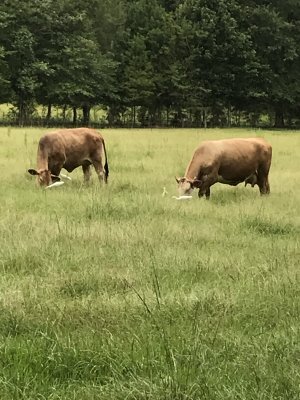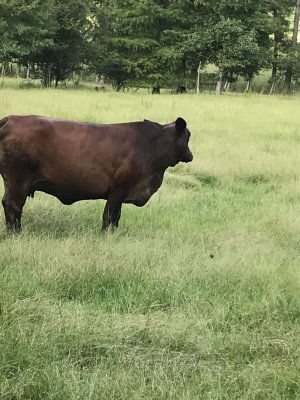greybeard
Well-known member
A question for those raising cattle (specifically cow/calf) on small acreage anywhere from about I-45 in Texas over to the East Coast. (Ga, Ala, Miss, South Tenn, Louisiana, Florida and Southern Arkansas.)
The following was written in regards to livestock production on "small acreage" which the writers define as 5-100 acres". They approve of backgrounding stocker calves on such property but basically say you can't do a cow/calf operation on the same size property.
This is what they say about cow/calf:
Why not cows? Some might wonder why a typical cow/calf operation would not work on small acreage. There are several reasons.
■ An 1100-pound cow will consume 22 to 33 pounds of forage or 1/2 a square bale of grass hay each day. If a typical stocking rate for native range is 25 acres per animal unit, then 100 acres might support only four animal units, assuming all 100 acres produce grass and are grazable.
■ It is not economically feasible to own a bull for fewer than 10 to 15 cows. Bulls require even more feed than cows and are hard on facilities and fences.
■ A cow/calf enterprise is not flexible. When drought reduces available forage, producers must either buy expensive feed or sell some cows to prevent overgrazing. This is the time when cattle prices are lowest. Then, after rains have come and grass has grown, producers buy more cows when prices are highest. With a sell low/buy high strategy, an operation can not be economically viable. ■ Facilities for managing large animals are expensive and reduce the acreage available for grazing.
■ A cow/calf operation requires considerable animal husbandry skill. A beef cow represents a $400 to $1000 investment. Naturally, the owner is economically and humanely compelled to care for the animals, but illnesses, injuries, birthing complications and preventive health programs often intimidate the inexperienced producer. Veterinary services can be expensive. Animals must be transported to a veterinary clinic in a trailer (another investment) or the producer must find a veterinarian willing to make "house calls."
The complete 7 pg article can be viewed at
The following was written in regards to livestock production on "small acreage" which the writers define as 5-100 acres". They approve of backgrounding stocker calves on such property but basically say you can't do a cow/calf operation on the same size property.
This is what they say about cow/calf:
Why not cows? Some might wonder why a typical cow/calf operation would not work on small acreage. There are several reasons.
■ An 1100-pound cow will consume 22 to 33 pounds of forage or 1/2 a square bale of grass hay each day. If a typical stocking rate for native range is 25 acres per animal unit, then 100 acres might support only four animal units, assuming all 100 acres produce grass and are grazable.
■ It is not economically feasible to own a bull for fewer than 10 to 15 cows. Bulls require even more feed than cows and are hard on facilities and fences.
■ A cow/calf enterprise is not flexible. When drought reduces available forage, producers must either buy expensive feed or sell some cows to prevent overgrazing. This is the time when cattle prices are lowest. Then, after rains have come and grass has grown, producers buy more cows when prices are highest. With a sell low/buy high strategy, an operation can not be economically viable. ■ Facilities for managing large animals are expensive and reduce the acreage available for grazing.
■ A cow/calf operation requires considerable animal husbandry skill. A beef cow represents a $400 to $1000 investment. Naturally, the owner is economically and humanely compelled to care for the animals, but illnesses, injuries, birthing complications and preventive health programs often intimidate the inexperienced producer. Veterinary services can be expensive. Animals must be transported to a veterinary clinic in a trailer (another investment) or the producer must find a veterinarian willing to make "house calls."
The complete 7 pg article can be viewed at
Last edited:



